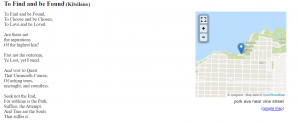Brief
Design a critical and cohesive overview of race, gender, identity, and intersectionality in the maker environment. Introduce others to representational problematics in makerspaces and communities.
Choose your means of presentation so long it is multimodal.
Project: Inclusive Makerspace Twine Game
This is an interactive text-based story surrounding a group of diverse makers that challenged the space’s gender norms and definition of “making” in the local makerspace the Iron Forge.
There are two main aspects of inclusivity that I focused on, specifically on gender and culture.
The story draws upon themes mentioned in the lecture by Kimberly Martin on Centering Gender: A feminist analysis of makerspaces and digital humanities centres especially the notions of the difference between “Making vs Crafting” and how that often is intertwined with the idea of “New Domesticity” when it comes to “softer” forms of making with sewing, knitting, weaving, etc. having it be dismissed as mere “craft”.
Another theme that really resonated with me in that lecture was the idea of “invisible labor” of women when it comes to expectations within makerspaces and the stereotypical gender roles affecting how work is organized into private and public spheres that in turn shape how we categorize tasks into “men vs women’s” work.
The narratives I have included are completely fictional and made with the help of ChatGPT. I wanted to utilize AI in this project as I was curious to see what stories it creates and the underlying biases and stereotypes that arises when it comes to inclusivity and diversity in makerspaces.
Below is an excerpt that I did not use in my story, but was given to me after prompting.
As the weeks passed, the dynamic between the men and women evolved. The men, who had been skeptical, began to respect the women’s leadership, learning new techniques and embracing projects they had never considered. Meanwhile, the women appreciated the technical knowledge the men brought, weaving it into their more holistic, creative projects. By the end of the month, the makerspace had become a true melting pot of ideas, where gender was no longer a barrier to creation. Men and women worked side by side, designing everything from wind-powered kinetic art installations to smart home devices that responded to voice commands. They learned from one another, breaking down stereotypes and building something even stronger: a community that thrived on diversity and collaboration. The women had taken charge, not by forcing the men out, but by expanding what was possible in the space—and in doing so, they had created a makerspace that belonged to everyone.
It felt like it was perpetuating the gender binary, even though there was one non-binary character in the story, and it felt like it was lumping “non-men” into one category of “women”. The erasure of non-binary-ness was somewhat surprising to me, and it played into a conundrum that I had when I was creating this project. Namely, the challenge of wanting to “break gender stereotypes” but needing to lean into and “exaggerate” the stereotypes in order to highlight that gap. I felt like that was the case when I was reading some of the papers, like by talking about under-representation first entailed the re-enforcement of gender stereotypes!
In terms of culture, I think the story reflects the kinds of cultural assumptions nested within the creation tools used in makerspaces, especially the recent tendency for integration of Arduinos, circuit boards, e-textiles to add the “Art” into STEM. Many papers seems to place an emphasis on empowering girls to participate more in science and computational activities, but it feels like there is less of a push to empower boys to lean into their artistic side. Seo and Richard (2021) mentioned that bidirectionally responsive design (BRD) activities were shown to “dissipate gendered preconceptions, and the learners across gender equally saw value of crafting, coding, sewing and design”, which might be a start, but I am curious to investigate more into such design-thinking and the more practical aspects in a broader context.
Ideally, I would have liked to include characters that are based on lived experiences, and to make sure that the representations of the characters are reflective of people with such positionalities that the characters themselves occupy. Potential development would be by asking friends with culturally relevant maker experiences to be part of the storytelling.
Should I have more time, I would have liked to explore more into disability and accessibility aspect of makerspaces in terms of content and subject matter.
In terms of the making of this artifact, I would have liked to find ways to embellish the story with more visual elements, such as photos of the makerspace, the characters, the kinds of projects they are making, etc. to create a more immersive and visual experience.
References
Martin, K. (2017, November 28). Centering gender: A feminist analysis of makerspaces and digital humanities centers [Video]. Media Collections Online. https://media.dlib.indiana.edu/media_objects/47429d523
Norris, A. (2014). Make-her-spaces as hybrid places: Designing and resisting self constructions in urban classrooms. Equity & Excellence in Education, 47(1), 63-77. https://doi.org/10.1080/10665684.2014.866879
Parekh, P. (2024). Girls’ reluctance and intersectional identities in STEM-rich makerspaces. Education Sciences, 14(6), 628.
Seo, J., & Richard, G. T. (2021). SCAFFOLDing all abilities into makerspaces: A design framework for universal, accessible and intersectionally inclusive making and learning. Information and Learning Sciences, 122(11/12), 795-815.


